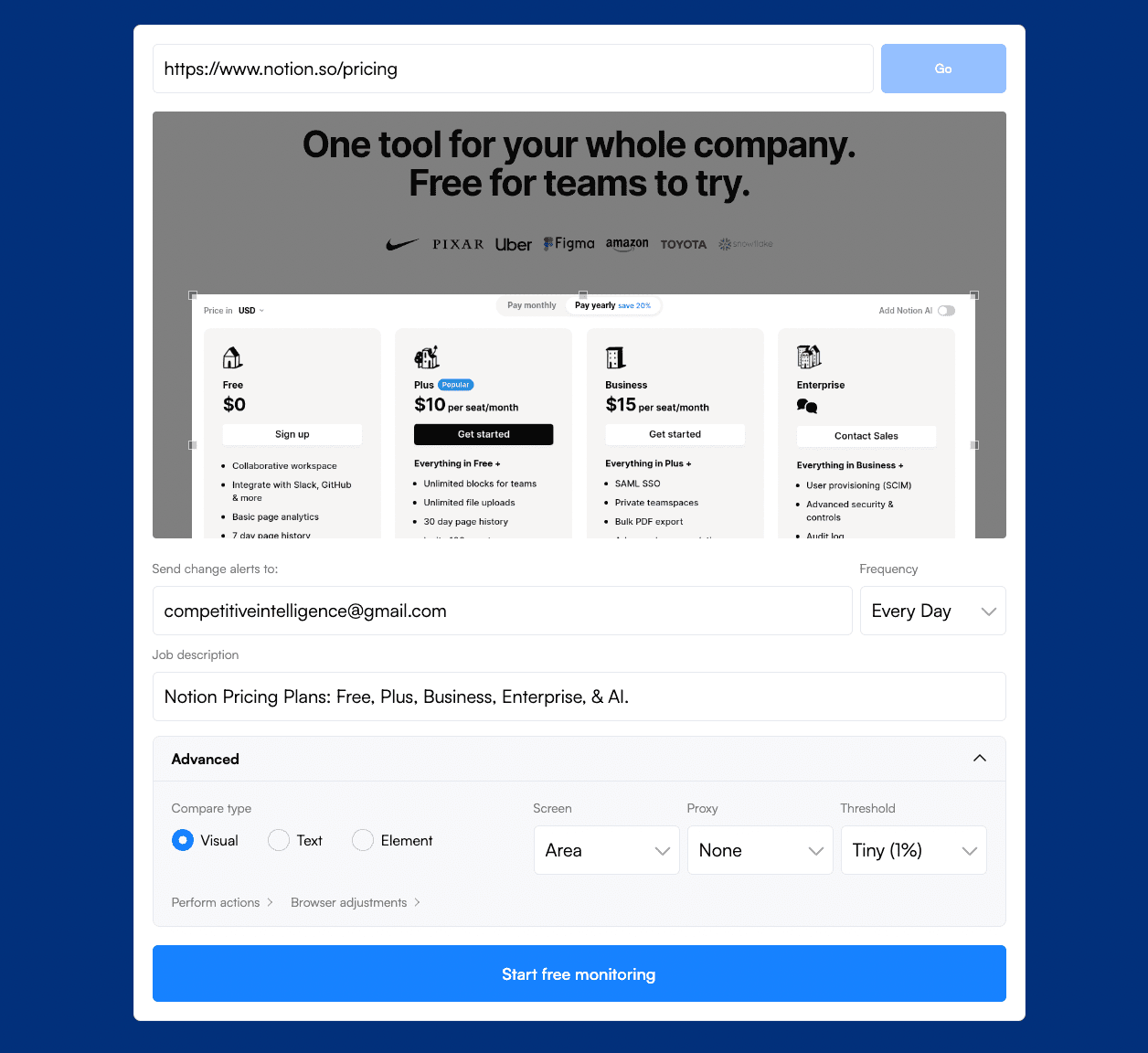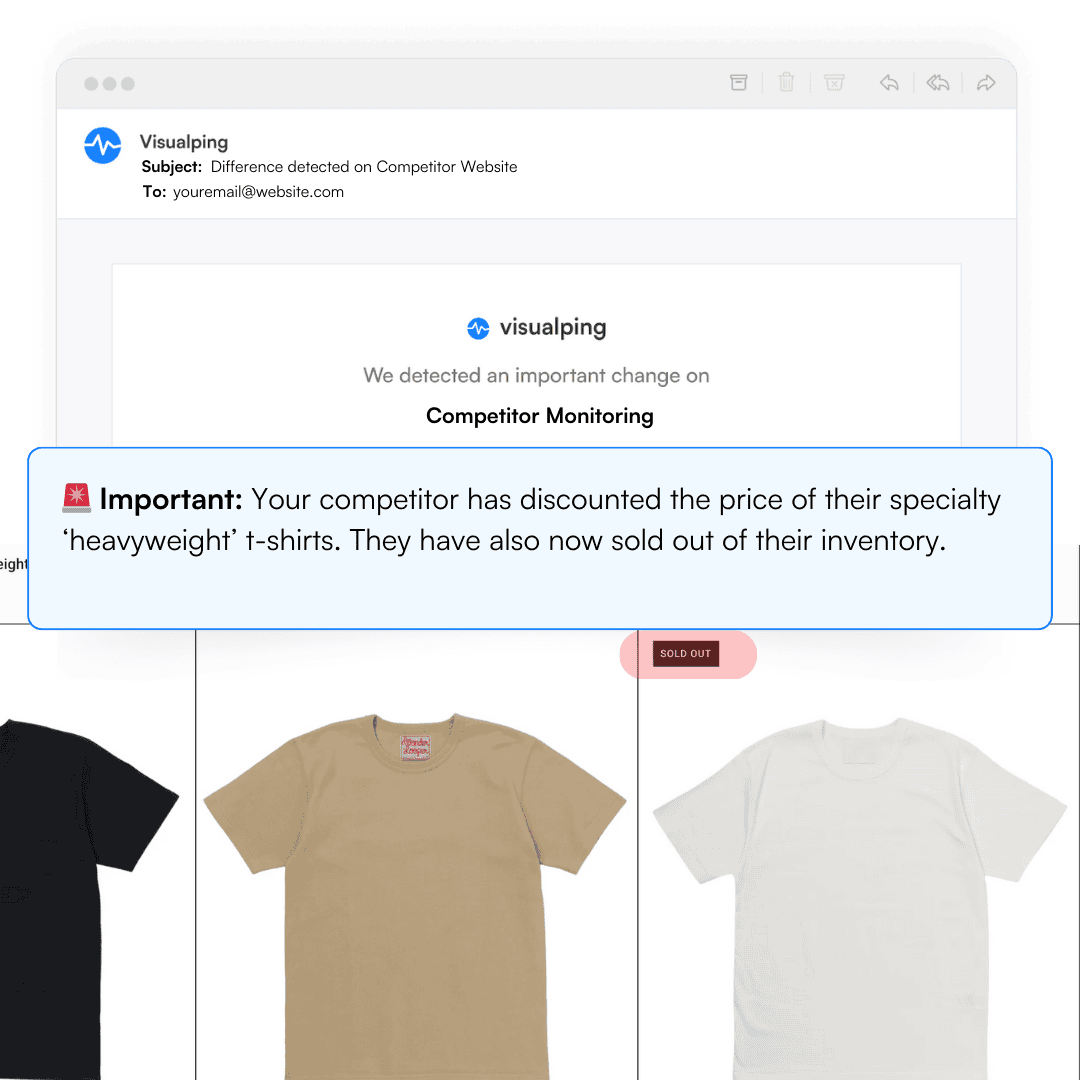Top Free Competitive Intelligence Tools in 2025
By Emily Fenton
Updated December 11, 2024

Top Free Competitive Intelligence Tools: Essential Solutions for Market Analysis
Competitive intelligence tools have become indispensable for businesses trying to get an edge over their competitors. Whether you sell software, cheese, or luxury cars – these tools provide valuable insights into competitors' strategies, market trends, and customer preferences, enabling you and your team to make informed decisions and stay ahead of the curve.
For organizations operating on tight budgets, free competitive intelligence tools offer a cost-effective way to gather market data. The best free competitive intelligence tools include popular options like Visualping, Semrush, and Similarweb which provide essential features for analyzing competitors and market trends without any financial investment.
By leveraging these free tools, you can learn a mountain of information about your competitors and the markets in which you compete. Your business can track and monitor your competitors to inform your strategic planning, product development, and marketing efforts.
Note that while these tools offer free versions, more comprehensive or sophisticated competitive intelligence gathering will require paid plans - offering more features, capabilities, and integrations.
Consider tracking key factors like pricing changes, new hires, new product launches, new content marketing releases, PR releases, SEO data, website redesigns, product positioning changes, and much more.
Understanding Competitive Intelligence
Competitive intelligence is a critical component of modern business strategy. It provides valuable insights into market dynamics, competitor activities, and industry trends that can shape decision-making and drive success.
Fundamentals of Competitive Intelligence
Competitive intelligence involves the systematic collection and analysis of information about competitors and the broader market environment. Nowadays, this research is typically conducted through competitor monitoring tools. This research can include various data sources, including tracking competitors' websites, public records, social media, customer feedback, and industry reports. The goal is to gain actionable insights that can inform strategic decisions.
Key elements of competitive intelligence include:
- Market research
- Competitor profiling
- SWOT analysis
- Trend forecasting
Effective competitive intelligence requires a structured approach to data gathering and interpretation. It often involves specialized tools and software that help businesses streamline the process and extract meaningful insights from large volumes of data.
Role of Competitive Intelligence in Digital Marketing
In the digital realm, competitive intelligence is vital in shaping marketing strategies. It helps businesses understand their online presence relative to competitors and identify opportunities for improvement.
Digital marketing aspects influenced by competitive intelligence include:
- SEO strategies
- Content marketing
- Social media engagement
- Pay-per-click advertising
Tools like Semrush provide valuable insights into competitors' digital marketing efforts. They allow businesses to benchmark their performance and identify areas for optimization. Companies can refine their digital marketing approaches by analyzing competitors' keyword strategies, content performance, and backlink profiles.
Benefits of Competitive Analysis for Businesses
Competitive analysis offers numerous advantages for businesses across various industries. It enables companies to stay ahead of market trends, identify potential threats, and capitalize on emerging opportunities.
Key benefits include:
- Improved product development
- Enhanced customer understanding
- More effective marketing strategies
- Identification of market gaps
By conducting regular competitive analysis, businesses can gain a competitive edge and make data-driven decisions. This process helps companies anticipate changes in the market, adapt their strategies accordingly, and maintain relevance in a rapidly evolving business landscape.
Competitive intelligence also aids in risk management by helping businesses identify potential threats and prepare contingency plans. It fosters innovation by revealing industry best practices and emerging technologies that can be adapted or improved.
Top Free Competitive Intelligence Tools
Competitive intelligence tools provide valuable insights into market trends, competitor strategies, and customer behavior. These platforms offer a range of features to help businesses stay ahead in their industries.
Web Page Monitoring with Visualping

Visualping is an AI-powered website change detection tool that allows users to monitor competitors' websites for updates. It sends emails alerts when specified changes occur on tracked web pages.
When a change is detected, you receive an alert that includes an AI-generated summary of the competitor update. It also includes a screenshot of the web page, with the changes highlighted.

Key features:
• Customizable monitoring intervals
• Visual and text-based change detection
• Email and SMS alerts
• Historical change logs
• AI Summaries and AI Analysis + Intelligent Alerts
The tool is handy for competitor price tracking, as well as getting notified of product updates, strategic marketing or positioning changes, customer reviews or sentiment updates, and content updates on competitor websites. Visualping provides a free tier with limited checks and paid plans for more frequent monitoring.
Details on SimilarWeb
SimilarWeb is a powerful website analysis tool that provides comprehensive data on web traffic and user engagement. It offers insights into website rankings, traffic sources, and audience demographics.
Key features include:
• Traffic analysis
• Audience insights
• Industry benchmarking
• Keyword research
SimilarWeb's free version gives users access to limited data, while paid plans offer more in-depth analytics. The platform is particularly useful for comparing website performance against competitors and identifying potential growth opportunities.
Insights from SEMrush
SEMrush is a versatile competitive intelligence tool that focuses on search engine optimization (SEO) and digital marketing. It provides detailed keyword analysis, backlink profiles, and competitor research.
SEMrush offers:
• Keyword tracking
• Site audit tools
• Backlink analysis
• Ad campaign research
The platform's competitive intelligence features allow users to monitor competitors' organic and paid search strategies. SEMrush's free plan provides basic functionality, while paid tiers unlock more advanced features and higher usage limits.
Capabilities of Ahrefs
Ahrefs is a comprehensive SEO toolset that excels in backlink analysis and keyword research. It offers detailed insights into competitors' link-building strategies and content performance.
Notable features include:
• Backlink checker
• Content explorer
• Rank tracker
• Site audit
Ahrefs provides a wealth of data on competitors' organic search performance and content strategies. While it doesn't offer a free plan, its paid tiers cater to businesses of various sizes and needs.
Utilizing Google Analytics
Google Analytics is a free web analytics service that provides valuable insights into website traffic and user behavior. It offers various data points to help businesses understand their online performance.
Key functionalities include:
• Traffic source analysis
• User behavior tracking
• Conversion tracking
• Custom reporting
While not primarily a competitive intelligence tool, Google Analytics can be used to benchmark performance against industry averages. Its integration with other Google services makes it a powerful addition to any CI toolkit.
Tracking Updates with Owletter
Owletter is a specialized tool for monitoring competitors' email marketing campaigns. It captures and analyzes email newsletters to provide insights into messaging strategies and promotional tactics.
Features include:
• Automated email collection
• Campaign analysis
• Design inspiration gallery
• Competitor trend tracking
By aggregating competitor emails, Owletter helps businesses stay informed about industry trends and promotional strategies. The platform offers a free trial and paid plans for ongoing monitoring.
Benchmarking with Klue
Klue is a comprehensive competitive intelligence platform focusing on real-time competitor tracking and analysis. It aggregates data from various sources to provide a holistic view of the competitive landscape.
Klue's offerings include:
• Product and pricing monitoring
• Marketing campaign tracking
• Sales battle cards
• Competitive landscape mapping
The platform lets businesses stay informed about competitors' strategies across multiple channels. Klue offers customized pricing based on specific business needs and scale.
Listening with Sprout Social
Sprout Social is a social media management platform with competitive intelligence features. It provides insights into competitors' social media performance and audience engagement.
Key capabilities include:
• Social Listening
• Competitor comparison reports
• Content performance analysis
• Audience demographics
By tracking competitors' social media activities, Sprout Social helps businesses identify trends and opportunities in their industry. The platform offers paid plans with varying levels of functionality.
Analyzing with BuzzSumo
BuzzSumo is a content research and social media analysis tool that provides insights into popular content and influencers across various platforms. It helps businesses understand what content resonates with their target audience.
BuzzSumo features:
• Content discovery
• Influencer identification
• Trending topic analysis
• Backlink monitoring
The platform allows users to analyze competitors' content strategies and identify opportunities for creating engaging content. BuzzSumo offers a limited free plan and several paid tiers with expanded functionality.
Researching with SpyFu
SpyFu is a competitive intelligence tool focused on search marketing. It provides detailed information on competitors' organic and paid search strategies.
SpyFu offers:
• Keyword research
• Ad copy analysis
• SEO ranking history
• Competitor comparison
The platform allows users to uncover competitors' most profitable keywords and ad strategies. SpyFu provides a free basic search, with paid plans offering more comprehensive data and features.
Effectively Monitoring Competitors
Competitor monitoring provides critical insights to inform business strategy and gain a competitive edge. Proper monitoring techniques, data analysis, and strategic application of competitive intelligence are key to staying ahead in today's fast-paced markets.
Best Practices for Competitor Monitoring
Effective competitor monitoring starts with identifying key rivals and metrics to track. Focus on direct competitors in your market segment and emerging players that could disrupt the industry.
Set up automated tracking tools to monitor competitor websites, social media, press releases, and other public channels. These tools can alert you to changes in pricing, product offerings, marketing campaigns, and more.
Establish a regular schedule for manual competitor research to supplement automated monitoring. This could include mystery shopping, analyzing financial reports, and attending industry events.
Create a centralized system to organize and share competitive intelligence across teams. This will ensure that insights are accessible to decision-makers when needed.
Auditing Digital Presence Across Platforms
A comprehensive audit of competitors' digital presence involves examining their activities across various online channels. This includes:
- Websites and blogs
- Social media profiles
- Review sites
- Online directories
- E-commerce platforms
Free Competitor Monitoring tools like Visualping can alert you to competitors' content marketing efforts, popular topics, formats, and distribution channels. This information helps your business refine your content strategies and identify gaps in the market.
E-commerce analysis tools provide insights into product listings, pricing strategies, and customer reviews on platforms like Amazon or eBay. This data informs pricing decisions and product development.
Using Competitor Updates to Inform Strategy
Competitor updates should drive strategic decision-making across the organization. When significant changes are detected, gather key stakeholders to assess the potential impact on your business.
Use competitor moves as inspiration for innovation. If a rival launches a new feature, consider how you could improve upon it or offer a unique alternative.
Analyze competitor pricing strategies to inform your own pricing decisions. Look for patterns in discounts, bundling, or premium offerings that could signal shifts in the market.
Pay attention to competitor marketing messages and channels. This can reveal underserved customer segments or emerging trends in customer preferences.
Gathering Competitive Intelligence Research
Competitive intelligence goes beyond simple monitoring to provide deep insights into competitor strategies and market dynamics. Start by defining clear research objectives based on your strategic priorities.
With Visualping, you can set up monitoring to gather data on your competitors from various online sources by monitoring the URLs of those web pages.
You can also supplement your monitoring by conducting primary research through customer surveys, industry expert interviews, and analysis of public financial data. This provides context to the data gathered through monitoring and secondary research.
Organize research findings into actionable reports and dashboards. Use data visualization techniques to highlight key trends and insights for decision-makers.
Competitor Strategies and Market Analysis
Analyzing competitor strategies is essential for predicting market changes and uncovering new opportunities. Examine trends in competitor behavior to understand their goals and priorities.
Map out each competitor's strengths and weaknesses relative to your own. This will help you identify areas where you can differentiate yourself or where you need to improve to remain competitive.
Track industry trends and macroeconomic factors that may influence competitor behavior. This broader context is essential for accurate market analysis.
Develop scenario plans based on potential competitor moves. This proactive approach allows you to prepare response strategies for various competitive situations.
Regularly reassess your competitive positioning and adjust strategies as needed. The competitive landscape constantly evolves, and agility is key to maintaining a strong market position.
SEO and Keyword Analysis
SEO and keyword analysis are important for improving website visibility and organic traffic. These techniques help identify valuable search terms and optimize content to rank higher in search results.
Optimizing for SEO and Keywords
Effective SEO starts with thorough keyword research. Tools like Semrush offer comprehensive keyword databases and competitor analysis features. Identify high-volume, low-competition keywords relevant to your niche.
Use these keywords strategically in your content, including titles, headings, meta descriptions, and throughout the body text. Focus on creating valuable, informative content that addresses user intent.
Optimize on-page elements such as title tags, header tags, and image alt text. Ensure your website has a clear structure and internal linking strategy to help search engines understand and index your content effectively.
Advanced Keyword Research Techniques
Go beyond basic keyword research by exploring long-tail keywords and semantic variations. These often have lower competition and can drive highly targeted traffic.
Analyze competitor keywords to uncover gaps in your strategy. Tools like Ahrefs provide insights into competitors' top-ranking pages and backlink profiles.
Use keyword clustering to group related terms and create comprehensive content that covers multiple related topics. This approach can help establish topical authority and improve rankings for a broader range of search queries.
Implementing SEO Analysis
Regular SEO analysis is essential for maintaining and improving search rankings. Conduct site audits to identify technical issues hindering performance, such as slow page load times or broken links.
Monitor keyword rankings and organic traffic trends. Track changes in search engine results pages (SERPs) to stay ahead of algorithm updates and shifting competitor strategies.
Analyze user behavior metrics like bounce rate and time on page to gauge content effectiveness. Use these insights to refine your SEO strategy and content creation efforts.
Managing SEO and Content Creation
Integrate SEO best practices into your content creation workflow. Develop a content calendar that aligns with your keyword strategy and addresses user needs throughout the buyer's journey.
Use content analysis tools to evaluate existing pages and identify opportunities for improvement. Update and optimize older content to maintain relevance and improve rankings.
Implement a consistent internal linking strategy to distribute link equity and guide users through your site. Regularly review and update your plan based on performance data and changing search trends.
Analyzing Customer Feedback and Sentiment
Customer feedback provides valuable insights into tool performance and user satisfaction. Reviews on platforms like G2 offer real-world perspectives from verified users.
Sentiment analysis of customer feedback helps identify the strengths and weaknesses of different tools. Positive sentiments often highlight data accuracy, comprehensive reporting, and time-saving capabilities.
Negative feedback can highlight areas needing improvement, such as insufficient data coverage or conv oluted pricing structures. This information is essential for both selecting tools and managing vendors effectively.
Regular analysis of customer sentiment allows organizations to stay informed about evolving tool capabilities and potential alternatives in the market.
Summary of Key Free Competitive Intelligence Tools
Visualping offers website change monitoring capabilities, alerting users to competitor updates. This tool proves invaluable for tracking pricing changes, product launches, and content modifications.
Semrush, Similarweb, and SE Ranking stand out as amongst the other top free competitive intelligence tools. These platforms provide comprehensive website traffic, keywords, and online visibility data.
Next Steps in Leveraging Tools for Growth
Begin by identifying specific competitive intelligence needs aligned with business objectives. Select tools that address these priorities and integrate them into existing workflows.
Establish a regular schedule for data collection and analysis. This ensures consistent monitoring of competitor activities and market trends.
Train team members on tool usage and data interpretation. Empower employees to contribute insights and foster a culture of competitive awareness.
Implement a system for sharing competitive intelligence across departments. This facilitates informed decision-making and alignment of strategies company-wide.
Set up automated alerts for critical competitor actions or market shifts. This enables swift responses to emerging threats or opportunities.
Combine tool-generated data with human analysis. While AI-driven insights are valuable, human expertise is the “secret sauce” for strategic interpretation.
Depending on your goals, you can’t go wrong with these highly recommended competitive intelligence tools. Although these tools offer free features, once you’ve built a foundation for your competitive intelligence strategy, you may have to consider upgrading your tech stack to the paid versions of these products.
Want to monitor web changes that impact your business?
Sign up with Visualping to get alerted of important updates, from anywhere online.
Emily Fenton
Emily is the Product Marketing Manager at Visualping. She has a degree in English Literature and a Masters in Management. When she’s not researching and writing about all things Visualping, she loves exploring new restaurants, playing guitar and petting her cats.